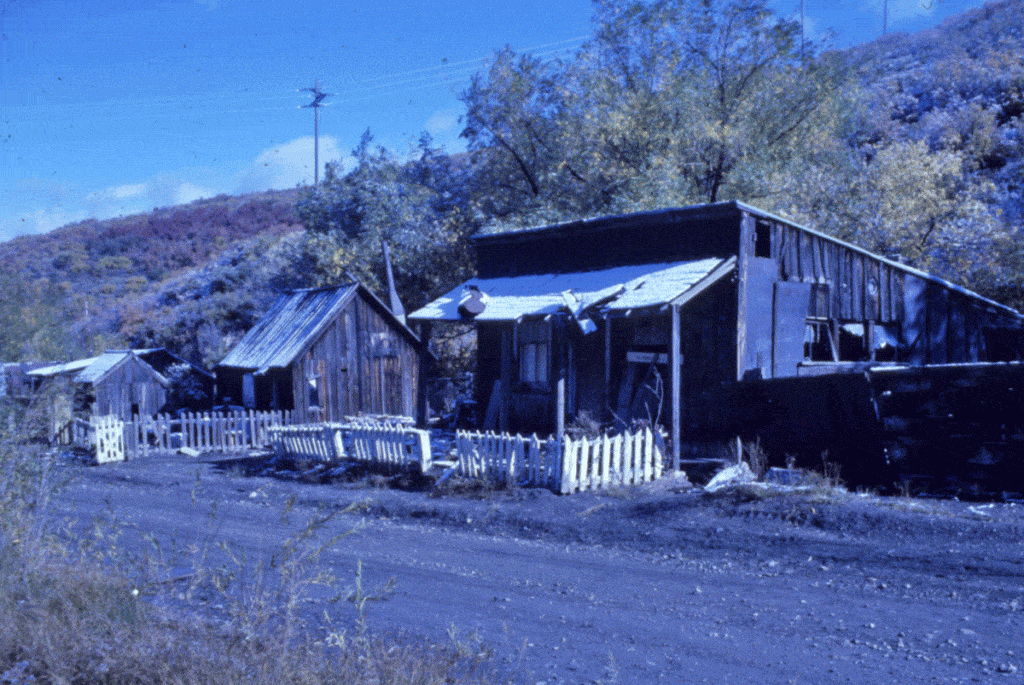Above Shoe Tree Park, just east of the Poison Creek Trail, an electrical box clings to a solitary pole in the middle of the creek. The box is empty, the meter long since removed, and there are no wires leading from the pole. What you see is the last visible reminder of a little community known as Easy Street.

Photo courtesy of David Hampshire.
There used to be a street there, of sorts, and its official name was Pacific Avenue. But no one ever called it that.
During the waning days of mining in Park City, Easy Street was the last refuge of people – often single men – who couldn’t afford to live anywhere else. It was, in the words of the late Park City historian Gary Kimball, “an unmaintained rut of a road that paralleled Poison Creek below Heber Avenue. Many old-timers and winos lived in shacks along the banks of the creek on Easy Street.
“I doubt there was one shack on Easy Street that had a refrigerator. Only a few of them had running water. Electricity usually consisted of a single bulb dangling from the ceiling, and the toilet was often an outhouse built over Poison Creek,” Kimball wrote.
“The area [now] referred to as Easy Street we called Bachelors’ Row, as that is what it was for many years,” Bea Kummer, another local historian, recalled in a 1979 Park Record column. Among the well-known characters who lived on Easy Street were Larry Bye, Santos Giauguitio, Bill Knox, and William Lake. For a brief period in the mid-1950s, the street also provided a home for Maurine Foster’s house of ill repute.
By the 1970s, Easy Street had attracted a new generation of residents looking for cheap housing as Park City turned to skiing. Among the newcomers were Gary Avise, Susan Prigge, Mitch Harrison, and Steve Lloyd.
However, by 1977 developer Edgar Stern had announced plans for a new ski resort in Deer Valley and the Utah Department of Transportation was surveying ground for a new highway to link Deer Valley with lower Park Avenue. Easy Street was in the way.

Credit: Park City Historical Society & Museum, Patricia Smith Collection
In the spring of 1979, Lloyd received a notice that his home had been condemned. Hearing this, Harrison went to City Hall to ask what other buildings were on the chopping block. “All of them,” he was told.
Lloyd and Harrison managed to find other places to live. But 70-year-old Bill Knox did not. In a letter to the Park Record in November 1979, Lloyd told readers that Knox had taken his own life.
“What does a 70-year-old person do, especially after living somewhere for a long period of time, when faced with eviction, and has nowhere to go because progress is bearing down on them?” Lloyd asked.
“My friend’s death signals the end of an era,” he wrote, “as with the destruction of Easy Street, the last of old Park [City] fades into the forgotten past.”
For more information on Easy Street and some of its colorful residents, watch for the upcoming publication of “Look Beyond the Sleeping Dogs: Portraits of a Vibrant Community in Park City’s ‘Ghost Town’ Era,” by Gary Kimball. A lifelong local resident, Kimball died in 2018. This book includes a number of previously unpublished stories about the author’s years growing up in Park City.